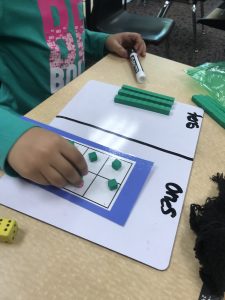
Tens and Ones.
To us, as adults, it seems so simple.
To a young child, however, it is such an abstract concept.
We understand that when we get to nine ones, adding one more will topple it over into the ten space.
First graders don’t grasp that. Not at first, at least.
We can make it easier for them by giving them a visual.
That’s where the magic of the place value blocks comes in.
Those little tiny ones cubes and tens rods can work miracles, I tell you.
![]()
By the time we’ve reached the Place Value unit in my classroom, my students are adept at using these little guys.
We used them heavily in our Numbers to 120 unit. They are familiar with the concept of tens and ones, but just in the basic understanding that the rods stand for tens and the cubes stand for ones. They know that 11 has one ten and a one, and 12 has one ten and two ones, etc. They can use them like that.
But our goal with the Place Value unit is much more than that. The Common Core State Standards want them to understand that if we add one cube, that is adding one, and if we add a rod, that is adding ten. We need to lay the groundwork for two-digit addition and subtraction. We need to lay the groundwork for regrouping.
Not an easy task, to say the least.
So, we start with the basics. Play a trading game with the blocks, a ten frame, and a die. Roll, add, trade if needed.

Again….roll, add, trade if needed. And again. And again. As students add the ones, they learn to trade ten ones for a ten rod and keep going.

Kids love this simple game, and it is SO important to help them develop that understanding of exc hanging place value.
hanging place value.
Young students need to have lots of experience with this game to make it concrete, to make it visible. They need to be able to close their eyes and visualize it like you and I can. With lots of practice, they will get there!
Then they can move on to understanding how to mentally find ten more or ten less.
Then they can understand that regrouping might be necessary when adding or subtracting.
![]()
Does your class need some practice with identifying two-digit numbers represented by place value cubes?
Click the picture below to grab a free scoot activity to use in your classroom!

Thanks so much for joining me for this quick little math chat! See you next Monday!

Leave a Reply